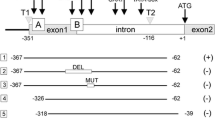Abstract
Heat shock factors (HSFs) are critical regulators of spermatogenesis. However, heat shock responses, the associated components and the underlying functional mechanisms remain to be elucidated. Here, we characterize the expression pattern of HSFY, a member of the HSF family in the testis and epididymis. Its expression in testis and epididymis was initially identified by western blots. Immunofluorescence staining demonstrated that HSFY was confined to the cytoplasm of late spermatocytes and spermatids in adult testes, gonocytes in newborn testes and undifferentiated spermatogonia in 7 days post-parturition testes. In the epididymis, HSFY was predominantly expressed in principal cells. Furthermore, a single transient scrotal heat stress did not change HSFY protein expression in the testes or epididymis, either on the expressional level or in cellular localization. In summary, this study detected the expression pattern of HSFY in the testes and epididymis and demonstrated that its expression was not regulated by transient elevated temperature.






Similar content being viewed by others
References
Ferlin A, Moro E, Rossi A, Dallapiccola B, Foresta C (2003) The human Y chromosome’s azoospermia factor b (AZFb) region: sequence, structure, and deletion analysis in infertile men. J Med Genet 40:18–24
Hamilton CK, Revay T, Domander R, Favetta LA, King WA (2011) A large expansion of the HSFY gene family in cattle shows dispersion across Yq and testis-specific expression. PLoS ONE 6, e17790
Hartl FU (1996) Molecular chaperones in cellular protein folding. Nature 381:571–579
Kinoshita K, Shinka T, Sato Y, Kurahashi H, Kowa H, Chen G, Umeno M, Toida K, Kiyokage E, Nakano T, Ito S, Nakahori Y (2006) Expression analysis of a mouse orthologue of HSFY, a candidate for the azoospermic factor on the human Y chromosome. J Med Invest 53:117–122
Paul C, Teng S, Saunders PT (2009) A single, mild, transient scrotal heat stress causes hypoxia and oxidative stress in mouse testes, which induces germ cell death. Biol Reprod 80:913–919
Pei Y, Wu Y, Qin Y (2012) Effects of chronic heat stress on the expressions of heat shock proteins 60, 70, 90, A2, and HSC70 in the rabbit testis. Cell Stress Chaperones 17:81–87
Pirkkala L, Nykanen P, Sistonen L (2001) Roles of the heat shock transcription factors in regulation of the heat shock response and beyond. FASEB J 15:1118–1131
Shinka T, Sato Y, Chen G, Naroda T, Kinoshita K, Unemi Y, Tsuji K, Toida K, Iwamoto T, Nakahori Y (2004) Molecular characterization of heat shock-like factor encoded on the human Y chromosome, and implications for male infertility. Biol Reprod 71:297–306
Soncin F, Zhang X, Chu B, Wang X, Asea A, Ann Stevenson M, Sacks DB, Calderwood SK (2003) Transcriptional activity and DNA binding of heat shock factor-1 involve phosphorylation on threonine 142 by CK2. Biochem Biophys Res Commun 303:700–706
Stahl PJ, Mielnik AN, Barbieri CE, Schlegel PN, Paduch DA (2012) Deletion or underexpression of the Y-chromosome genes CDY2 and HSFY is associated with maturation arrest in American men with nonobstructive azoospermia. Asian J Androl 14:676–682
Tessari A, Salata E, Ferlin A, Bartoloni L, Slongo ML, Foresta C (2004) Characterization of HSFY, a novel AZFb gene on the Y chromosome with a possible role in human spermatogenesis. Mol Hum Reprod 10:253–258
Vinci G, Raicu F, Popa L, Popa O, Cocos R, McElreavey K (2005) A deletion of a novel heat shock gene on the Y chromosome associated with azoospermia. Mol Hum Reprod 11:295–298
Xu YM, Huang DY, Chiu JF, Lau AT (2012) Post-translational modification of human heat shock factors and their functions: a recent update by proteomic approach. J Proteome Res 11:2625–2634
Author information
Authors and Affiliations
Corresponding author
Ethics declarations
Funding
This work was supported by the Earmarked Fund for Modern Agro-Industry Technology Research System (CARS-44).
Conflict of interest
The authors declare that they have no conflict of interest.
Informed consent
Informed consent was obtained from all individual participants included in the study.
Rights and permissions
About this article
Cite this article
Zhang, W., Shao, Y., Qin, Y. et al. Expression pattern of HSFY in the mouse testis and epididymis with and without heat stress. Cell Tissue Res 366, 763–770 (2016). https://doi.org/10.1007/s00441-016-2482-y
Received:
Accepted:
Published:
Issue Date:
DOI: https://doi.org/10.1007/s00441-016-2482-y



